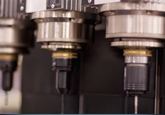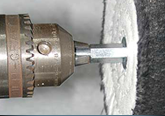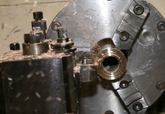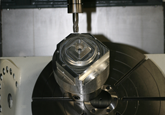Material Removal
In the machining process of material removal, the cutting tool removes the unwanted materials from the workpiece to produce the desired shape. The workpiece can be from a variety of stock materials such as aluminum, steel, titanium, wood, stone, ceramic, glass, etc., as well as from forged or casted materials. The materials being machined, the type of material removal – boring, grinding, milling, polishing, etc., the final product precision requirements, and other factors will determine the required spindle specs.
Listed below are the most common material removal applications. You don't see your application here? Not a problem. Our modular production philosophy allows our on-site engineering team to quickly customize one of our base model spindles to meet your specific needs. Contact us today and one of our knowledgeable spindle associates will guide you to the perfect spindle for your application.
Boring/Drilling
When selecting a spindle for boring or drilling – also referred to as hole-making – there are a few factors to consider. These include the hole diameter and depth, the tolerance required, and whether the hole will require additional machining such as threads or a recessed top to accommodate fasteners. These factors will determine the type of spindle best suited for your particular application. All Dynomax spindles are built to handle the unique power, torque, speed and precision requirements for boring and drilling...
Buffing/Finishing/Polishing
When selecting spindles for buffing, finishing or polishing applications, you want a spindle that will allow the tool to gently glide over the finished part. Therefore, it's important to spec high-speed spindles that feature high RPMs and low horsepower (HP) for nominal torque. Dynomax offers a multitude of high-speed spindles to finish your jobs...
Grinding/Dressing
Grinding, or dressing, spindles are designed to do just that – grind away metal, glass, ceramics or other materials with a grinding wheel to the desired shape or finish. The size and configuration of the spindle will vary depending on the specific grinding application and environment. Because of the harsh environments in which they typically operate, all Dynomax abrasive grinding spindles employ our proprietary Dynogrind technology: a hard, durable metal alloys that protect and extend the life of the external spindle housing, and a sealing system that outperforms other products in the industry, increasing spindle life form months to years...
Turning
With applications in industries such as agriculture, construction, packaging, production and mining, among others, turning spindles are quite versatile. They're most commonly used in horizontal or vertical lathes and turning centers. Key characteristics of Dynomax's turning spindles are that they maintain thermal stability under varying temperatures, are relatively compact in design and can withstand the vigor of high-speed cutting forces...
Milling
Milling is the most common type of material removal, and includes applications such as Engraving, Facing and Routering. Milling spindles are widely used in applications where high speed material removal rates and/or high precision surface finishes are required. Dynomax offers a large variety of milling spindles with features that can increase machine productivity, reduce tool wear, and support tight part tolerances. Whether belt-driven or motorized, standard or high-speed, we have just the right spindle for your milling application...








